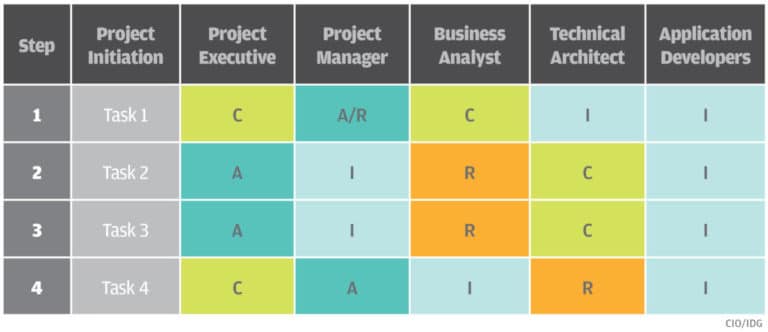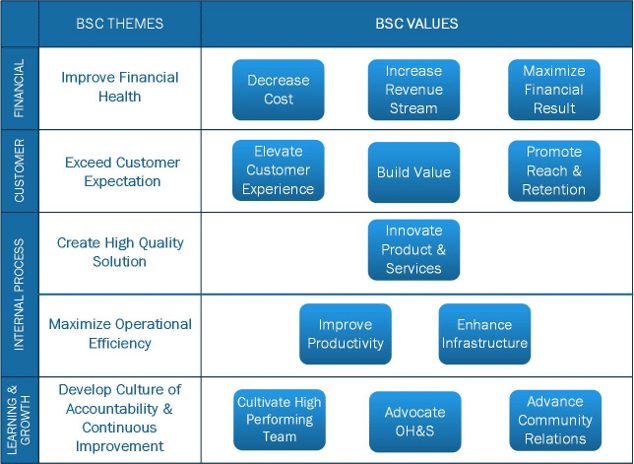
Why Change to a Metric Driven Culture? A winning culture keeps score. In sports, everyone knows what winning looks like. It’s reflected in the score, plain and simple. In many businesses, however, people have no clue what winning would mean. Employees can’t get excited about winning, because they never know whether they’re winning or not. They need a score to tell them.
Performance Management tools help drive productivity and achieve high performance by enabling the company to measure and manage what matters, correct behaviour accordingly and create accountability to deliver excellent products and services to customers.
Accountability in the workplace is about creating a proactive atmosphere of responsibility instead of laying down a strict set of rules. It is all about setting and holding people – from the part-time hourly worker to the C-suite executive – to a common expectation of accomplishing business goals. This is done by clearly defining the company’s mission, values, and goals and aligning everyone to them. From there, you can define the metrics that will work to achieve those goals and measure performance against them.
The bottom line is that accountability is necessary. Even though it is difficult to achieve, it is attainable with the right tools and team on your side. There are many performance management tools to improve accountability, reduce rework and improve productivity. We will go over some of our commonly used performance management tools below.
Productivity is enhanced by well-defined, challenging goals. No other single factor has more impact on employee engagement than clearly defined goals.
OKR is a form of strategic goal setting, standing for Objectives and Key Results. It is a collaborative goal-setting protocol for companies, teams and individuals. OKR’s are used for setting and tracking objectives to help ensure that the company focuses efforts on what truly matters. At a basic level, OKR’s are a collaborative and agile approach to setting corporate goals, creating focus, alignment, accountability and acceleration and are used by every level of the organization.
OKRs done right will advance the business while other approaches may keep you treading water. While, like many other goal setting techniques, they are designed to focus and commit to priorities and track accountability, OKRs are defined by their focus on “Stretching for Amazing.” In other words, they are designed to challenge you and stretch your goals beyond what you think you can achieve, thus improving your professional development, which improves company growth.
OKRs and KPIs work perfectly together. KPIs help monitor performance and identify problems and areas for improvement; OKRs help solve problems, improve processes, and drive innovation. You’ll need both.
Key Performance Indicators, also known as KPIs, are measures used to track the operation of your organization and indicate progress toward a desirable outcome. While you may track many things relating to your business, it is important to identify a subset that is “key” to your overall success. KPIs should be operational, strategic and achieving them should lead to the success and sustainability of the business in the long term.
A good metric for a KPI meets 3 conditions:
Examples of good KPIs:
One tool that we sometimes choose to use is a RACI – a responsibility/ accountability model used to eliminate role confusion, clarify hand-offs and boundaries, and prevent over/under allocation of resources
In a recent client engagement, the client had difficulty completing projects on time and under budget. Job descriptions were not standardized, and executives often completed work not appropriate to their levels.
Our team implemented a RACI tool that aligns each task to the appropriate job title. The client received a matrix diagram, allowing each employee to understand what they should be doing and ensuring the right person is optimally assigned to the right task.
Communication and visibility quickly improved, and roles are now optimized, enabling the client to complete projects on time and under budget while its employees are now more satisfied with their roles.
A RACI is a grid, with columns as job titles, and rows as each unique task in a department of the company. It is used to identify who is Responsible, Accountable, Consulted or Informed at each step in a process.
Responsible – Who is completing the task. (one person)
Accountable – Who is making decisions and taking actions on the task(s). (one person, possibly the same person as “responsible”)
Consulted – Who will be communicated with regarding decisions and tasks.
Informed – Who will be updated on decisions and actions during the project.
By having one person responsible and accountable for the task, it eliminates the issue of having “too many cooks in the kitchen”, which slows decision making down, and gives accountability to the singular person whose job it is to make the decision or complete the task.

A Balanced Scorecard (BSC) is a strategy performance management system that allows managers to keep track of how the staff is executing activities and allows them to align strategic activities to the strategic plan. It guides your organization to set, track and achieve their strategic vision by ensuring they are not only doing things right but are doing the right things right. The BSC can be used by individuals or departments to understand the status of the organization and its component parts, or during meetings to focus discussion and planning.
A Balanced Scorecard helps manage and guide progress by tracking Key Performance Indicators (KPI’s).
A Balance Scorecard (BSC) builds your objectives to measure yourself against key pillars of your organization (i.e. financial, customers, organizational capacity and internal processes), and track KPIs against your goals. The idea is that each perspective should be evenly measured and improved so that everything is balanced.
Readily available information allows decisions to be made strategically and quickly and align business metrics with their vision and values, customer needs and wants, and employee objectives and performance.
To date, some form of a Balanced Scorecard is used by nearly 60% of Fortune 500 companies
One of our clients was a worldwide leader in their industry, however, due to enormous growth, had not invested in proper business infrastructure or management processes. TPG was engaged to help put in place new infrastructure and strategy and was asked to architect an overall communications and change management strategy.
A Balanced Scorecard (BSC) was implemented to improve the tracking and communication of performance with the goal of informing the direction and efforts of the organization.
TPG analyzed existing strategic objectives, all functional areas and current reporting structure. We then developed a BSC framework and structure for both corporate and departmental scorecards and determined the departmental-to-corporate roll-up process. Leveraging existing strategic priorities, we then developed future-state strategic objectives on both corporate and departmental levels, with alignment with senior leadership of the organization. We then organized and prioritized a list of KPIs for each strategic objective.

After the BSC was built out, with strategic objectives and KPIs determined, we provided the necessary training and manuals to the Scorecard leads and a corporate calendar to include workback schedules and deadlines for key players.
One year later the company was operating at record capacity and had gained over a million dollars in value. A combination of strategic planning and performance management tools supported the organization in implementing its broader strategic objectives.
A Master Calendar is a year over year budgeting, strategy creation, marketing planning, assortment planning, purchasing, replenishment management, promotional planning and execution cadence system. This tool outlines all meetings, high-level milestones, Standard Operating Procedures (SOP’s) for those meetings, key attendees across all departments and has a calendar view.
A Master Calendar will set you up for success by enforcing ongoing discussions and review of progress over the year(s) and across departments.
A Master calendar can help to:
There are also many other performance management tools that you can use to improve different areas of your company, the ones listed above are just some of our favourites we use to kickstart a company’s journey to high performance.
However, performance management tools are just that – tools that need to be applied, practiced and nurtured over the medium and long term. Like any significant change or improvement, it will require active buy-in and participation from all employees at every level to be sustainable and create real improvements.